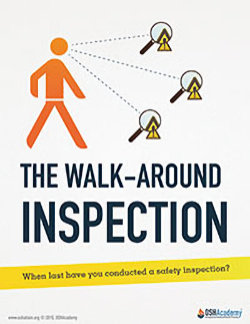Safety Inspections
Conducting safety inspections is the most common method to identify hazards in the workplace. The frequency of inspections should be based on the nature of the hazards in the workplace.
Safety inspections are usually conducted by safety committees and supervisors. Below are some best practices to follow when conducting a safety inspection:
- Plan ahead: Create a checklist of areas and tasks to inspect before conducting the inspection. Identify any potential hazards and determine the appropriate tools or equipment needed for the inspection.
- Focus on high-risk areas: Prioritize areas that have a higher risk of accidents or incidents, such as areas with heavy machinery, hazardous chemicals, or confined spaces.
- Involve employees: Involve employees in the inspection process by soliciting feedback and suggestions. Employees are often the best source of information about potential hazards and can provide valuable insights into ways to improve safety.
- Follow established protocols: Follow established protocols and procedures when conducting the inspection, including wearing appropriate personal protective equipment (PPE) and adhering to any lockout/tagout procedures.
- Use inspection tools: Use inspection tools, such as thermometers, gas detectors, and noise meters, to gather accurate and objective data about potential hazards.
- Document findings: Document all findings from the inspection, including any hazards identified and any corrective actions taken. This documentation can help ensure that hazards are addressed and can also serve as a record of the inspection.
- Take corrective action: If hazards are identified during the inspection, take immediate corrective action to eliminate or control the hazards. Follow up to ensure that corrective actions have been effective and that hazards have been eliminated or controlled.
By following these best practices, safety inspections can help identify potential hazards and improve workplace safety.
In June 2020, a serious incident occurred at a manufacturing facility in Ohio involving a batch operator and a concrete mixer. The operator was injured while attempting to manually close a pneumatic discharge door after the handle of a critical exhaust valve - designed to disable the door during maintenance—had broken off and was not repaired. The door closed unexpectedly, causing a severe head injury. The operator was hospitalized and died five days later.
A federal investigation led to a workplace safety violation, a $500,000 fine—the maximum allowed - and a court-ordered Safety Compliance Plan.
This case highlights the role that thorough, routine safety inspections can play in identifying and addressing equipment issues before they result in serious consequences. A damaged or missing control mechanism like a broken exhaust valve is precisely the type of hazard that should be identified during a structured inspection.
Key inspection takeaways from this incident include:
- Plan ahead: Include critical equipment like pneumatic systems and valves on inspection checklists.
- Prioritize high-risk areas: Equipment with moving parts or stored energy should be regularly reviewed.
- Involve employees: Operators can often identify early signs of malfunction or wear—encourage their input.
- Follow protocols: Use appropriate PPE and apply lockout/tagout procedures when inspecting powered equipment.
- Document and act: Record findings and ensure any damage is repaired promptly, with follow-up checks to confirm the fix.
Regular inspections, paired with immediate corrective action, are essential to preventing incidents and maintaining a safe work environment.
Knowledge Check Choose the best answer for the question.
5-4. A supervisor is preparing for a safety inspection. Which action follows best practice?
You forgot to answer the question!

